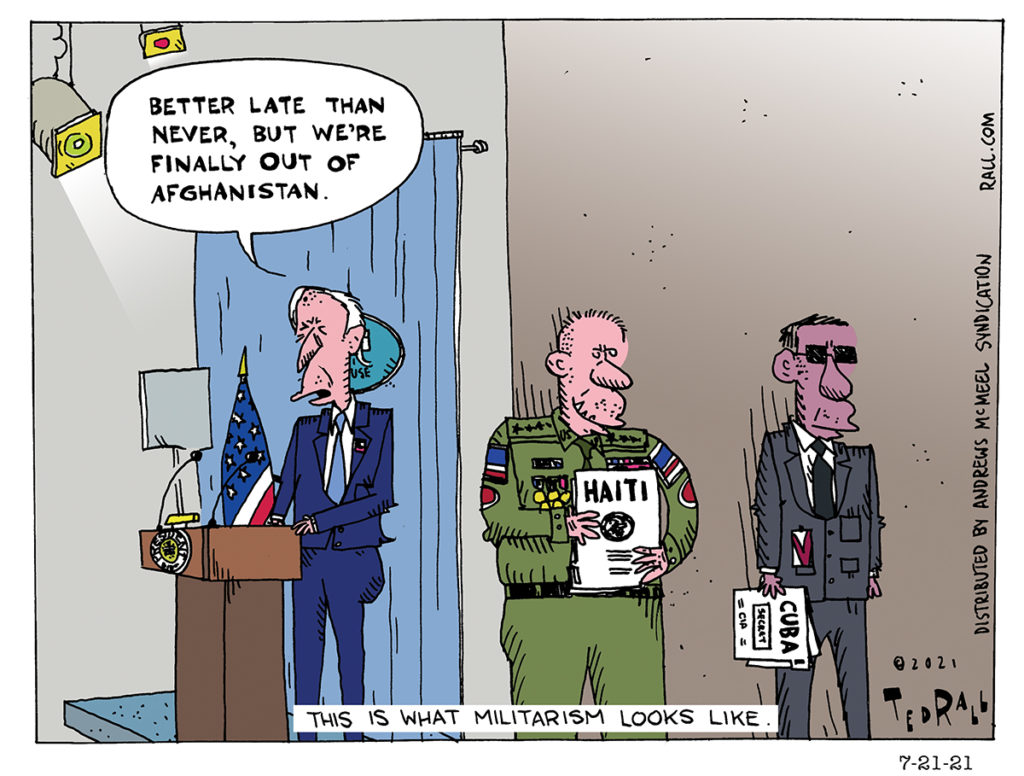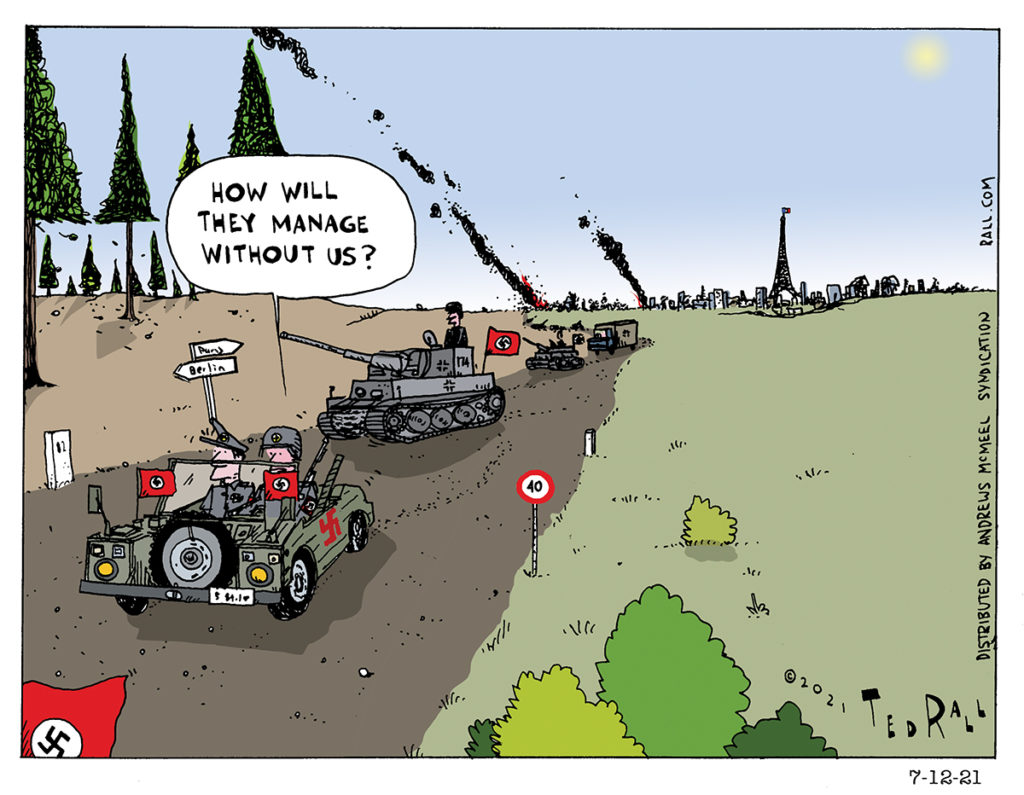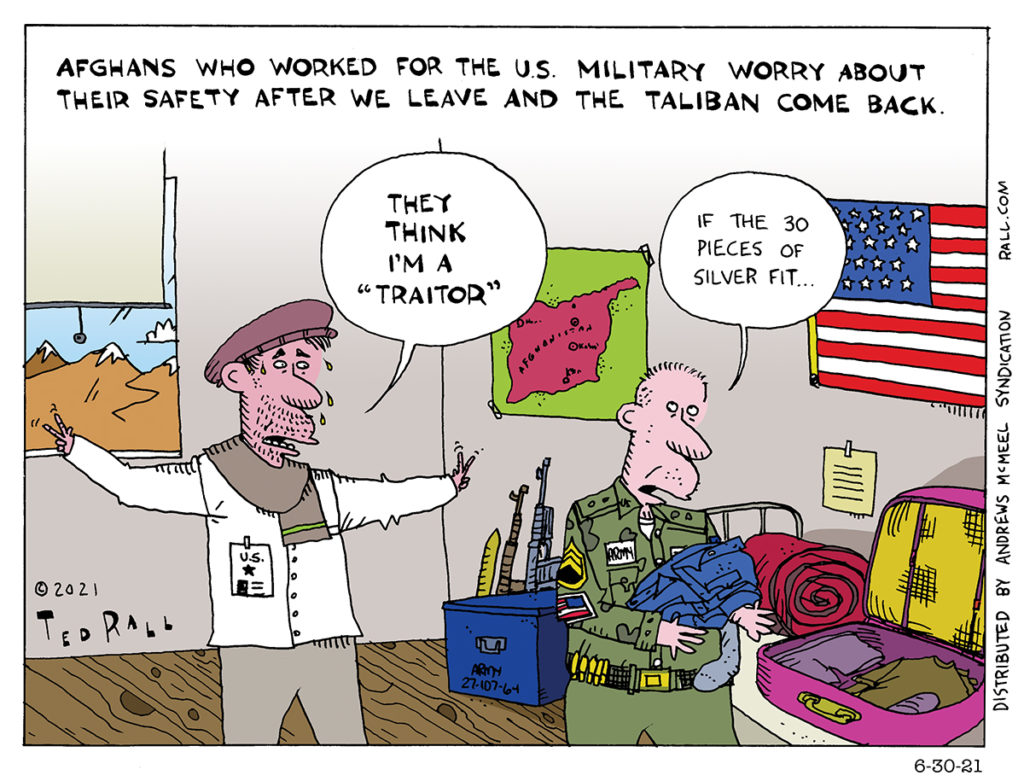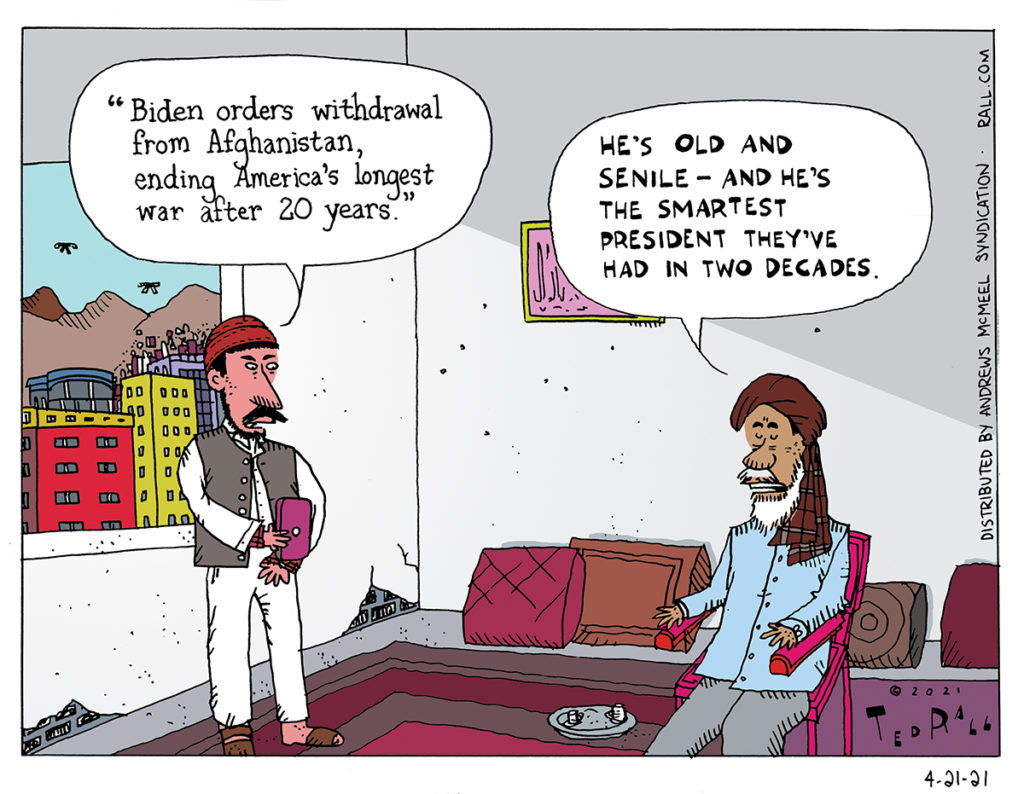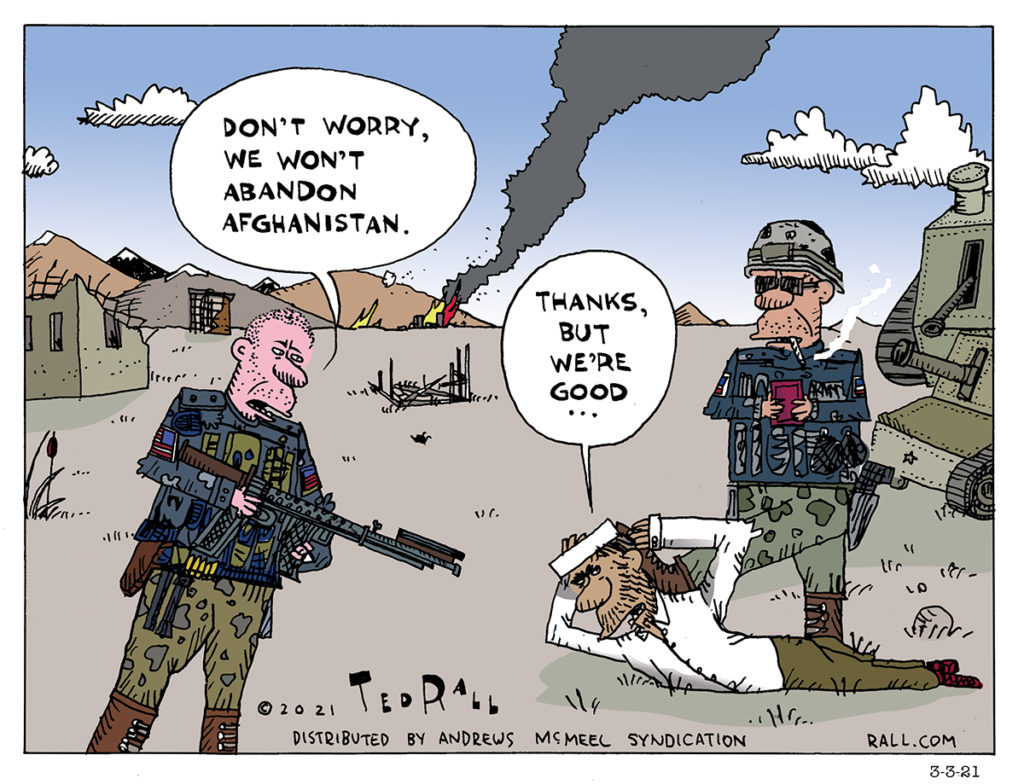Fortunately, president Joe Biden followed through on last year’s peace deal with the Taliban and has ordered a complete withdrawal from Afghanistan. A war we never should have been in in the first place is coming to an end. But militarists are waiting in the wings with new ideas for mayhem for profit.
The Worst Countries for Women (Afghanistan Isn’t on the List)

Concern-trolling over the dismal plight of women in Afghanistan is powerfully appealing to liberals who look for reasons for the United States to maintain a military presence there. If and when the Taliban return to power, the warmongers argue, the bad old days of stonings, burqas and girls banned from school will come back—and it’ll be our fault because we didn’t stick around.
Outrage over women’s inequality is often only ginned up in the service of some other aim, like invading Afghanistan or banning transwomen from high school girls’ sports teams. Scratch the thin veneer of phony feminism and the true agenda, which has nothing to do with women or girls, is quickly exposed.
You may be surprised to learn that, according to a U.S. News & World Report analysis of data provided by the United Nations, Afghanistan isn’t among the ten worst countries for women. Which nations do have the worst gender inequality?
A list of staunch pals of the U.S.
But you’ll never see “woke” news media go after the U.S.’ best bros for treating women like dirt, much less the suggestion that these countries ought, like Afghanistan, to be bombed, droned, invaded and subjected to two decades of brutal occupation under a corrupt U.S.-installed puppet regime.
#1 worst nation in the world for women is the United Arab Emirates (“close friends and strong allies…with shared interests and common values,” crows the UAE’s embassy website, which showcases a cute photo of Biden). Common values that we apparently share with the UAE are its form of government (tribal autocracy), the torture and disappearance of political dissidents, female genital mutilation, wife beatings (perfectly legal), marital rape (perfectly legal) and “honor killings” (frowned upon and largely ignored). Women may vote, drive, buy property, travel and go to college. But they need signed permission from their “guardian”—who is usually their father or their husband.
Continuing down the list, we find U.S. “strategic ally” Qatar (#2), U.S. ally Saudi Arabia (#3), U.S. “treaty ally” India (#4), U.S. “partner” Oman (#5), major recipient of U.S. military aid Egypt (#6), U.S. “major non-NATO ally” Morocco (#7), U.S. ally South Korea (#8), U.S. “regional strategic ally” Sri Lanka (#9) and U.S. “key partner” Jordan (#10). Anyone who cares about the oppression of women should backburner Afghanistan, start with the UAE and work their way down this list of misogynist nightmare nations.
Not to say that the women of Afghanistan don’t have anything to worry about as the Taliban return to power. They do. Taliban spokesmen tell reporters that they’ve moderated their views about the status of women since 2001, that they would even allow women to work as judges and will now allow girls to continue their education and for women to work so long as they wear hijab. “Local sources told us the Taliban removed art and citizenship classes from the curriculum, replacing them with Islamic subjects, but otherwise follow the national [U.S.-backed government] syllabus,” the BBC reports from Balkh province near Mazar-i-Sharif. “The government pays the salaries of staff, but the Taliban are in charge. It’s a hybrid system in place across the country.”
Reality in areas controlled by local Taliban commanders hasn’t corresponded with this relatively cheery and pragmatic vision. There are reports that the Taliban have demanded that girls over 15 and widows under 45 be forcibly married and, if they aren’t Muslim, converted to Islam. Taliban rule will likely be harsher and stricter in more rural areas.
It is perfectly reasonable to worry about the future of Afghan women. Though, to be fair, many were viciously oppressed, forced to wear the burqa, denied an education and even stoned to death, throughout the last 20 years of U.S. occupation. If you don’t, you are morally deficient.
But don’t forget the hierarchy of needs: women are even worse off in a number of other countries, all of which get a pass from the American press and giant chunks of American tax dollars from the American government. So the next time you hear someone affiliated with the U.S. government or in mainstream corporate media talking about how the Taliban mistreats women, remember that their real agenda is oppression and militarism, not emancipation.
(Ted Rall (Twitter: @tedrall), the political cartoonist, columnist and graphic novelist, is the author of a new graphic novel about a journalist gone bad, “The Stringer.” Now available to order. You can support Ted’s hard-hitting political cartoons and columns and see his work first by sponsoring his work on Patreon.)
The Taliban’s Dramatic Military Victory
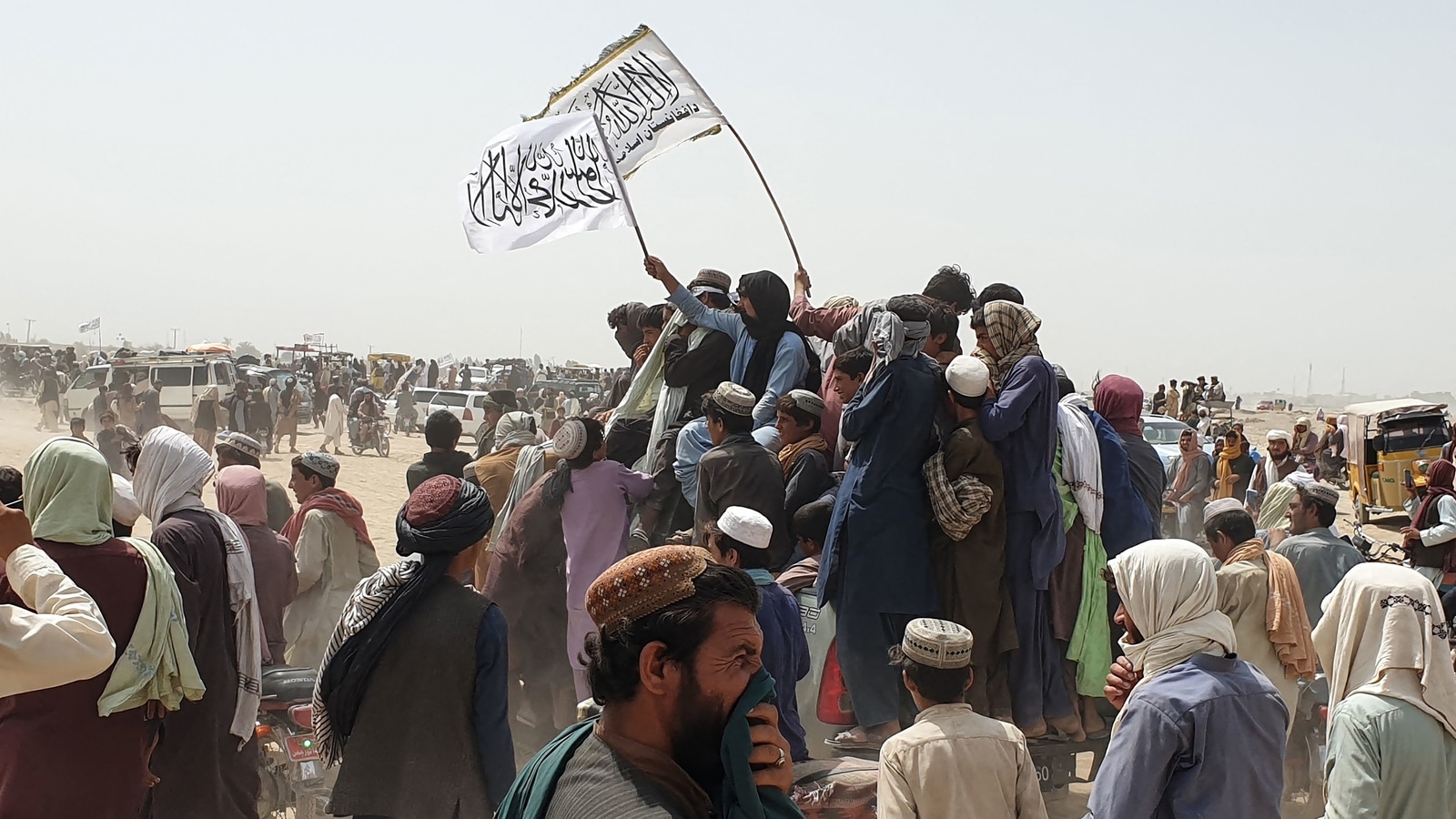
Now that President Biden has pulled the U.S. military out of Afghanistan, it’s clear that we have little to show for more than $2 trillion and thousands of soldiers killed over two decades of occupation. We will soon be back where we were on September 10, 2001, when the Taliban governed Afghanistan.
Afghan government troops have neither the will nor the training to protect their corrupt leaders in Kabul. Defeat of an Afghan government sinking in passivity and denial will occur within months or weeks.
Soldiers of the regime installed by the administration of George W. Bush and propped up by his successors are deserting and fleeing across the border to Tajikistan. Taliban troops have surrounded and briefly taken over both Kunduz, a city whose wobbly back-and-forth allegiances make it an Alsace-like wartime bellwether, and Herat, long considered unconquerable because it was controlled by Ishmail Khan, a former Northern Alliance warlord long considered the nation’s fiercest and most competent opponent of the Taliban. The Taliban can and will return for good.
They recently captured key border crossings with Iran, Turkmenistan and Tajikistan. The Iran border post alone generates about $20 million per week in customs duties—revenue that now belongs to the Taliban.
Kabulis await the inevitable triumph of the Taliban, resigned to whatever fate awaits them.
Even tongue-shaped Badakhshan province on the remote northeastern border with China is “on the verge of falling completely” to the Taliban. Badakhshan was the Northern Alliance’s last redoubt, the only section of the country that successfully resisted the Taliban when the militants ruled between 1996 and 2001.
Media coverage about the coming transition will focus on the plight of women, the role of ISIS, reprisals and the return and style of sharia law. What will be lost, but deserves to be noted as well, is that the Taliban have just achieved a stunning military victory.
Never in recent history, not even in Vietnam or in Afghanistan against the British in the 19th century, has a rural guerilla army achieved such a dramatic defeat against a colossus that held every military, political and economic advantage.
With the most sophisticated fighter jets in the world, hundreds of cruise missiles and a huge fleet of assassination drones, the U.S. enjoyed complete dominance of the skies throughout the war. The Taliban didn’t have a single plane. Whereas the Viet Cong were enthusiastically armed and trained by China and fought alongside the nation-state of North Vietnam, poorly-sourced reports allege that the Taliban may have received—at best—sporadic, extremely limited support from Iran and Russia. They were forced to live underground, constantly hiding from American forces.
Not only did the Taliban win a protracted war against the world’s biggest superpower, that superpower is leaving them a brand-new nation built from the ground up. Twenty years ago, Afghanistan was a failed state with 14th century infrastructure. Roads, all unpaved, didn’t even have names. There was no electricity, no phones, no sewage, no running water. There wasn’t even a banking system.
The United States is leaving them $8 billion worth of roads and highways, a $1 billion power grid, dams, canals, levees, drainage systems, bridges, tunnels, airports, the Internet, you name it. 85% of the country’s population is covered by cellphone service; that’s not true of the Hamptons.
We have gifted the Taliban $36 billion in infrastructure spending.
You’re welcome.
Military historians will study the Taliban insurgency for years to come. In the meantime, empires like the U.S. and resistance movements like the Taliban can each draw important lessons.
Whether they are an indigenous movement like the Taliban resisting foreign invasion or a revolutionary organization seeking to overthrow a domestic government, anyone who seeks to take on a state with superior manpower, training and weapons should take the failure of the U.S. invasion of Afghanistan as proof that an inferior force need not be intimidated by such daunting disparities. From the revolutions in France, Russia and China to the anti-colonial struggles in Africa and Asia, many notable regime changes have succeeded despite the odds. If you have the support of the people and relentless dedication to fight steadfastly through countless setbacks, you can prevail in an asymmetric conflict. This is particularly true if your adversary is foreign and requires domestic political will and to maintain long and expensive supply lines.
Big powers like the U.S. can impose their will overseas, but within limits. It is possible to imagine an alternative scenario in which the U.S. might have succeeded in Afghanistan. First and foremost, the United States should have allowed Afghans, a fractious people united only by their opposition to foreign domination, to choose their own leaders rather than sidelining the exiled king at the 2002 loya jirga. Installing Hamid Karzai, a paid CIA operative, as president, was a catastrophic misstep. Brazenly interfering with Afghanistan’s internal politics re-legitimized the Taliban’s message that Westerners are corrupt and exploitative hypocrites and exposed our rhetoric about self-determination as hollow.
Allowing democracy to run its course would have been risky but smart. Walking our talk and keeping our thumb off the scale would have outweighed the downside risk that Afghans might have elected the “wrong” leaders.
(Ted Rall (Twitter: @tedrall), author of the books “To Afghanistan and Back” and “After We Kill You We Will Welcome You as Honored Guests: Unembedded in Afghanistan,” is also the author of a new graphic novel about a journalist gone bad, “The Stringer.” Now available to order. You can support Ted’s hard-hitting political cartoons and columns and see his work first by sponsoring his work on Patreon.)
How Will They Manage without Us?
As the United States completes its pullout from Afghanistan, the usual suspects worry aloud that the country won’t be able to manage without us. What they and other people with a neo-colonialist mentality don’t realize is that Afghanistan is a sovereign country and that we have been interfering with it unnaturally for 20 years.
Abandon Afghanistan and Don’t Look Back

Joe Biden deserves nothing but praise and support for his decision to honor America’s commitment, negotiated between the Trump administration and the Taliban, to finally withdraw from Afghanistan. After more than 20 years of wasted lives, endless property damage and squandering of billions of U.S. tax dollars that would have been better spent on just about anything else you could think of, it’s incredible that corporate media is still giving airtime to the idiots and warmongers who want to keep troops over there. “I have heard general after general, as you have, say, just give us a little more time,” ABC’s Martha Raddatz said July 4th.
It’s been two decades. There was no legal or moral justification for the war to begin with. They’ve had too much time as it is.
For those of us who have been closely connected to America’s longest war last week’s abandonment of Bagram airbase, the biggest U.S. facility in occupied Afghanistan, makes the long-promised withdrawal feel real.
And the hand-wringing over what comes next has built to a fever pitch. Will the Taliban come back? Will it be like 1997 all over again, with women subjugated and horribly oppressed? Will the Taliban kill the translators, fixers and other Afghans who worked for U.S. occupation forces? Will Afghanistan once again become a staging ground for terrorist attacks like 9/11?
Some of these questions are reasonable. Others couldn’t be less so, based as they are on assumptions fed by lies.
What’s important to remember is the motivation for sewing these doubts. The military industry and its pet media outlets want to change our minds about withdrawal or, if they fail to do so for now, to set the stage for ground troops to invade again in the near future.
Afghanistan will not “again” become a staging ground for terrorist attacks against the United States or any other Western power because it was hardly one in the first place. In 2001 there were four Al Qaeda training camps in Afghanistan; there were 6,000 in Pakistan. On 9/11 Osama bin Laden was almost certainly in Pakistan, not Afghanistan. The attacks were planned by Khalid Sheikh Mohammed in Pakistan. Most of the funding came from the royal family of Saudi Arabia, as did 15 of the 19 hijackers; none came from Afghanistan. It is true that the hijackers all trained in Afghanistan but that’s a distinction without a difference; they could just as easily have picked up the same education in Pakistan, where 99% of Al Qaeda’s infrastructure and personnel had been situated.
There is good reason to worry about the immediate future after we leave. It is likely that the Taliban will quickly topple the militarily inferior and wildly unpopular U.S. puppet regime installed by the George W. Bush Administration. Neighboring countries are bracing for flows of Afghan refugees; hundreds of Afghan government soldiers have already fled to Tajikistan. Violence is inevitable: military casualties in the civil conflict, reprisals against political opponents and repressive acts against women and other targets of Muslim fundamentalists. But nothing can change the truth: Afghanistan is not a U.S. colony. It is a sovereign nation. As such, it has the right and duty of self-determination. The Afghan people must sort out amongst each other what kind of future they want to have.
In the event of a Rwanda-scale genocide, intervention could be justified in conjunction with an international force under the auspices of the U.N. At this writing, however, that seems unlikely. The Taliban are far more sophisticated, younger and modern than the regime that took over Kabul in 1996. So is the population that they seek to govern. Afghans are interconnected with the wider world and its culture via the Internet and cellular phones. They are Muslim extremists, but they are far more pragmatic than ISIS. Afghanistan under the Taliban will feel more like Pakistan than ISIS-held Syria. As is currently the case, rural areas will be more conservative—burqas, girls banned from schools, the occasional stoning—than the cities.
Certainly the United States has the moral obligation not to repeat its habit of discarding its local employees after withdrawal. We should offer green cards and economic support to our Afghan collaborators on an expedited basis rather than the shameful foot-dragging that has been reported. Otherwise the Taliban may execute them as traitors.
Be prepared, as Biden’s September 11, 2021 deadline for withdrawal of the last U.S. troops draws closer, for a rising chorus of voices calling for him to change his mind. Don’t abandon Afghanistan again, the war pigs will cry.
Don’t listen to their siren song of imperialism. The invasion was a mistake, the occupation was a mistake, and so was our propping up of our corrupt puppet regime. We never should have been there in the first place and it has taken 20 years too long to get out.
(Ted Rall (Twitter: @tedrall), the political cartoonist, columnist and graphic novelist, is the author of a new graphic novel about a journalist gone bad, “The Stringer.” Now available to order. You can support Ted’s hard-hitting political cartoons and columns and see his work first by sponsoring his work on Patreon.)
End Military Aid to Israel

Riding in the back of a truck into Afghanistan during the 2001 U.S. invasion, a journalist colleague from Russia who served in the Red Army during the 1980s asseverated that he was happy to be back in country. “Because this time,” he said, swinging his hands to indicate the swarms of refugees, bombed-out villages and nearby artillery fire, “all this shit belongs to you.” He pointed at me, the American. I looked around and immediately drew the obvious conclusion: we should get the hell out of Afghanistan.
That was 20 years ago. We were just getting in. But us being us—trying to win hearts and minds with corrupt proxies—and the Afghans being the Afghans—only able to agree on one thing, their intolerance of foreign domination—humiliating defeat and withdrawal were inevitable from the start.
It would be impossible to overstate the advantages of not doing something, of not playing any role, of standing aside and allowing a situation to evolve or devolve without any involvement on your part. Like in the movie “War Games,” you win by doing nothing.
This is a lesson that American foreign policy makers need to internalize more than any other. So do American voters, constantly tricked into lesser-of-two-evils conundra. We don’t have to vote for either lousy candidate. We don’t have to get involved in other countries’ politics or their wars. When all the options in a given situation stink to high heaven, the morally-correct choice is to sit on your hands and let someone else wallow in the morass.
The latest ebullition of violence between Israel and Palestine makes the case for isolationism. Militant right-wing Jewish settlers encouraged and protected by the government of corrupt Prime Minister Benjamin Netanyahu are trying to evict hundreds of Palestinian families from homes they have owned for decades in East Jerusalem, the Arab-dominated future capital of a Palestinian state if one is ever established. The settlers argue in court that the land in question was originally owned by a Jewish trust and should revert accordingly. However, as The New York Times notes, the apartheid regime treats people differently depending on their ethnicity: “Israeli law allows Jews to reclaim ownership of land they vacated in 1948, but denies Palestinians the right to reclaim the properties they fled from in the same war.”
The Israelis are brutalizing protesters and bombing Gaza; the Hamas government of Gaza is firing rockets into Israel. As usual, Israel is deploying disproportionately more violence: 67 Gazans and 7 Israelis have died so far.
The United States government sometimes pretends to be an “honest broker” in the Middle East crisis. Truth is, we have our fat thumbs on the scale and everyone knows it. The abyss between our yay-peace-and-democracy rhetoric and the reality of our foreign policy is a steaming pile of hypocrisy.
The U.S. turns a blind eye to Israeli violence and theft of Arab land, rarely lifting a finger to move toward a two-state solution while loudly decrying Arab violence against Israelis. The U.S. sends $4 billion a year to Israel—enough to give free healthcare to 1.4 million Americans if we wanted to. Joe Biden recently restored $235 million in assistance to the Palestinian Authority that had been cut off by Trump—less than one-sixteenth of the package to Israel.
When the Israeli Air Force bombs apartment buildings full of civilians in densely-populated Gaza City, Palestinians get blown to bits using guided bombs and missiles fired from F-16s and F-35s made in Texas and California. The IDF targets street demonstrators in the West Bank with teargas canisters and stun grenades fired from launchers manufactured by a company based in Pennsylvania.
Israel’s mayhem is brought to you by America. Few Americans are aware of that. But Palestinians and Muslims around the world are.
Even if you support the existence of the Jewish state, and even if you think the Boycott, Divestment, Sanctions (BDS) movement against Israel goes too far, you should be able to view ending U.S. military aid to Israel (without boycotts or other sanctions) as a moral imperative. It would also be a smart foreign policy choice that would reduce global anti-Americanism as well as the chances of a future 9/11-type terrorist attack.
Contrary to Likud propaganda, cutting off military assistance would not create an imminent existential threat. Between the $85 billion of U.S. aid to Israel since 1949, its robust economy and closer ties to many of its Arab neighbors, there is little danger that this tiny, ferocious country would get pushed into the sea. And if that were to change, we could reevaluate the situation and resume funding—assuming Israel decided to try to make peace and were to cooperate with the establishment of a free and independent Palestine.
It is hardly surprising that Israel’s right-wing government cashes the blank check to do whatever the hell they feel like that we send them every year. The only way we can hold Israel accountable for repeated escalations, land grabs and ongoing brutality is to stop sending the gravy train. Will cutting off the cash change their behavior? Maybe. Whatever Israel decides to do on its own, however, it will do without our blessing and without our funding.
Often the best thing to do is nothing at all.
(Ted Rall (Twitter: @tedrall), the political cartoonist, columnist and graphic novelist, is the author of a new graphic novel about a journalist gone bad, “The Stringer.” Now available to order. You can support Ted’s hard-hitting political cartoons and columns and see his work first by sponsoring his work on Patreon.)
Afghanistan Under the Taliban: It Won’t Be Like Last Time
We’ve been in Afghanistan 20 years, Joe Biden’s generals told him. All we need is a little more time. The president overruled them, ordering a complete withdrawal of American troops by September 11th.
Madiha Afzal and Michael O’Hanlon of the Brookings Institution articulate the opposition to Biden’s decision to call it quits. Remove the U.S. occupation forces that have maintained stability, they worry, and civil war will soon follow, culminating in the overthrow of the U.S.-backed government in Kabul and the return of the Taliban. They think it will be the late 1990s all over again: women back under burqas, stonings, 14th century Islam providing a safe haven for anti-Western terrorist groups like Al Qaeda.
“The most likely outcome of any quick troop exit this year is very ugly, including ethnic cleansing, mass slaughter, and the ultimate dismemberment of the country,” Ms. Afzal and Mr. O’Hanlon write in USA Today. “No one can see the future, of course, but this type of outcome seems much more likely than any smooth transition to a new government run by a kinder, gentler, more moderate Taliban.” They urge a slower long-term drawdown.
I think they’re wrong.
I’m not clairvoyant. Yet I did foresee that the U.S. would follow the British and Soviet armies and meet defeat in the Hindu Kush: “We’ve lost this war, not because they’re good or we’re not, but because of who we are,” I wrote from Afghanistan in December 2001, where I worked as an unembedded reporter for The Village Voice. “The American Empire can’t spend the bodies or the time or the cash to fix this crazyass place, because in the final analysis, election-year W. was right—we’re not nation builders.”
Unlike the Brookings authors I’m more optimistic about Afghanistan without U.S. occupation forces than with them. First, whatever stability the U.S. and its allies have brought to Afghanistan is as artificial as the finger of the Dutch boy plugging the hole in the dike. The rural-based Taliban are like the sea, an inevitable force waiting to pour in. Whether or not we care for the end result, we can’t forestall the inevitability of a people’s self-determination at the cost of American and Afghan lives.
More importantly, the coalition presence has changed Afghanistan forever. When the Taliban ran most of the nation from 1996 to 2001, their draconian measures satisfied a desperate need for security in a place overridden with banditry, opium trafficking and addiction. Infrastructure was nonexistent: no phones, no electricity, no paved roads, no central monetary system. Afghans asked me to take their photos with my digital camera because no one owned a mirror; this was the first time in their lives they could see themselves.
Though security remains an issue, the coalition has built roads and highways throughout the country. We haven’t built a nation. But we have installed stuff. Cellphone service is more reliable and affordable than in the U.S. Cities like Kabul, Mazar-i-Sharif and Herat are bursting at the seams with new construction. Access to the Internet is widespread in urban areas. Mineral and oil reserves, previously untapped due to lack of capital investment, are beginning to come online thanks to China and other countries.
Two decades of occupation have changed culture in surprising ways. Herat, in the northwest near the borders with Turkmenistan and Iran, was dotted with pizzerias when I was there in 2010. Young men in Mazar brazenly ignored strictures against drinking and eating during the daytime during Ramadan. I saw a couple making out in a park in Kabul.
The Taliban, or more precisely the neo-Taliban who have replaced them, are more moderate because they operate in a modernized environment.
Though they share their name and religious fundamentalism with their ascetic forebears who grew up in the madrassas lining Pakistan’s tribal areas, today’s neo-Taliban are sophisticated cynics, men more concerned with making money then enforcing sharia law. The Taliban burned poppy fields. The neo-Taliban profits from them. The Taliban first gained popular support in 1996 by killing kidnappers. The neo-Taliban runs checkpoints and ambush points where they seize victims and hold them for ransom. So while the world has just cause for concern about what happens next, we should understand that forthcoming evils will be new ones, not a simplistic replay of Taliban 1.0.
In a country where every gunman is for hire, the regime installed by the United States in 2001 relies far more on funding than direct military defense. With more than $12 billion in aid pouring in from last year through 2024, the government led by Ashraf Ghani could easily outlive most expectations. Still, it’s not hard to imagine the U.S. and its Western allies losing interest and cutting the cash flow after 2025, opening a power vacuum that the Taliban—which either fully controls or vies for control of 67% of Afghan districts—would fill.
Concern that Afghanistan will return to the barbarism of the late 1990s and that Afghan women will suffer dramatic setbacks is misleading because, in the rural majority of the country, the politics and culture of the late 1990s never disappeared. Women never stopped wearing the burqa and continue to be stoned to death, most recently last year in Ghor Province. Young boys are routinely raped, a practice to which American troops were ordered to turn a blind eye. Were the Taliban to return to national power, life in most of Afghanistan wouldn’t change.
Nor would the more liberal cities be greatly affected. Afghanistan’s economy generates nearly $20 billion in annual GDP. An incoming national government run by the profit-oriented neo-Taliban would be hesitant to interfere with the engine of that economic activity, the big cities and the “ring road” highway network that connects them. We would probably see a crude version of the “one country two systems” form of governance that China uses in Hong Kong: girls schools and tolerance for personal freedoms in central Kabul, sharia law and grinding poverty out in the sticks.
As demonstrated by their engagement in the Doha peace process overseen by the Trump Administration, the neo-Taliban want trade and formal diplomatic ties with other countries, something the Taliban could not obtain from 1996 to 2001, when they were totally isolated from the rest of the world. The need to maintain international connections would be a moderating influence, making worst-case scenarios like harboring extremist groups, ethnic cleansing and disintegration unlikely.
None of this is to say that Afghanistan will become a Central and South Asian paradise if and when the neo-Taliban come to power in Kabul. The corrupt and dogmatic neo-Taliban will likely function as an authoritarian narcostate with trappings of rough religiosity, like a hardscrabble Saudi Arabia that exports heroin. Afghanistan will present new challenges. But it will be mostly up to the people of Afghanistan—traumatized, energetic and influenced by 20 years of Western values—to address them.
(Ted Rall (Twitter: @tedrall), the political cartoonist, columnist and graphic novelist, is the author of the upcoming graphic novel about a journalist gone bad, “The Stringer.” Now available to order. You can support Ted’s hard-hitting political cartoons and columns and see his work first by sponsoring his work on Patreon.)

